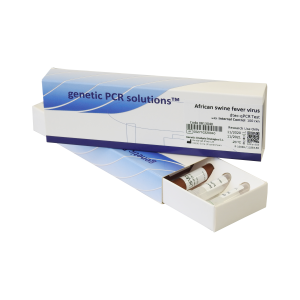
Bacterial swine diarrhoea dtec-qPCR Panel (BSDiarrhoea-Panel-3)
Description
The Bacterial swine diarrhoea-Panel-3 comprises a series of species-specific targeted reagents designed for detection of Brachyspira hyodysenteriae, Brachyspira pilosicoli and Lawsonia intracellularis by using qPCR. Enteric bacterial infections are among the most common and economically significant diseases affecting swine production worldwide. Clinical signs of these infections include diarrhea, reduced growth rate, weight loss, and death of preweaned, weanling, grower-finisher, young and adult age breeding animals. This panel was designed to detect three microorganisms related with the bacterial swine diarrhoea. Brachyspira hyodysenteriae (formerly Treponema hyodysenteriae and Serpulina hyodysenteriae) is a Gram-negative, motile, loosely coiled spirochete belonging to Brachyspiraceae family. This pathogenic bacteria colonizes the large intestine of pigs causing dysentery. Swine dysentery is easily spread by the faecal-oral route due to the ability of B. hyodysenteriae to survive several weeks in moist faeces from infected pigs. Brachyspira pilosicoli (formerly Serpulina pilosicoli) is a Gram-negative, spiral-shaped, obligate anaerobe bacterium member of the Spirochaete family. It causes intestinal spirochaetosis in pigs. Infection of B. pilosicoli is acquired the faecal-oral route. Once in the alimentary tract, the bacterium produce oedema, haemorrhage and the infiltration by inflammatory cells. Lawsonia intracellularis is a Gram-negative, obligated intracellular bacterium belonging to Desulfovibrionaceae family. It causes intestinal hyperplasia mainly in pigs. The disease has two clinical manifestations in pigs: an acute hemorrhagic diarrhea and sudden death of pigs close to market age often called proliferative hemorrhagic enteropathy; and a chronic mild diarrhea with poor growth performance in grower-finisher pigs referred as porcine intestinal adenomatosis.
Tritrichomonas foetus is a single celled flagellated protozoan parasite that is known to be a pathogen of the bovine reproductive tract. In cattle, the organism is transmitted to the female vagina and uterus from the foreskin of the bull where the parasite is known to reside. It causes infertility, and, at times, has caused spontaneous abortions in the first trimester.
Campylobacter fetus is a species of Gram-negative, motile bacteria with a characteristic “S-shaped” rod morphology. C. fetus causes abortion in cattle and sheep. There exist two subspecies: C. fetus subsp. venerealis and C. fetus subsp. fetus. Both are responsible of abortions by using different mechanisms of transmission. Campylobacter fetus subsp. venerealis is the causative agent of bovine genital campylobacteriosis, asymptomatic in bulls the disease is spread to female cattle causing catarrhal inflammation in the female genital tract, temporary infertility and prolonged oestrus cycle. Endometritis prevents implantation until the infection is cleared and causes early embryonic death and occasionally sporadic abortion. Campylobacter fetus subsp. fetus uses a different infection mechanism usually spread through faecal-oral transmission, causing sporadic abortion and early embryonic death.


